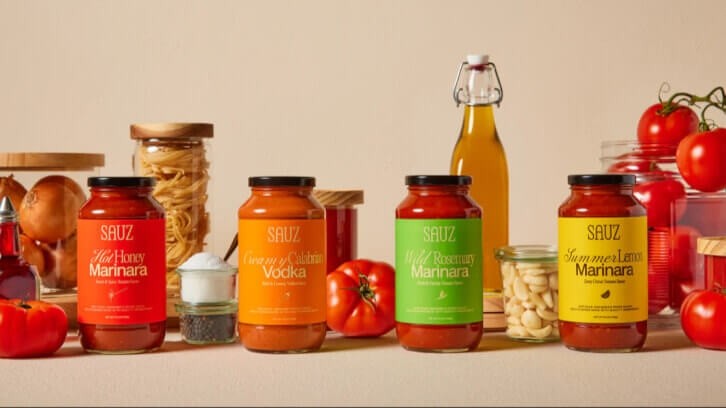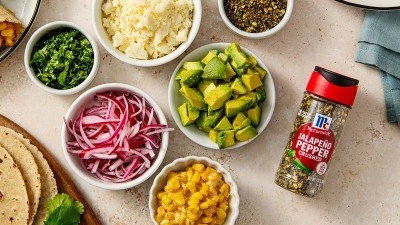SAUZ seeks to re-awaken the pasta sauce category with a Gen Z focus

Launched in 2023, SAUZ has quickly grown, starting with 300 retailers and targeting 3,000 by year’s end. The company ambitiously projects a 2,500% increase in sales by the end of 2024.
Bonde and Alfieri built the company as students at the University of Southern California, with a focus on “flavor-forward, experiential pasta sauce,” after seeing a lack of innovation in the category.
SAUZ features four flavors in Hot Honey Marinara, Summer Lemon Marinara, Creamy Calabrian Vodka and Wild Rosemary Marinara. With a direct-to-consumer shop at getsauz.com, the sauces retail at $24.99 for a two pack of 25-ounce jars.
SAUZ also is available at Whole Foods, Erewhon, Central Market and Town & Country Markets. The brand recently announced its retail launch in Gelson’s this month.
‘Why don’t we put this in pasta sauce?’
SAUZ intends to disrupt the pasta sauce aisle by differentiating itself through novel flavor combinations made with ingredients that are “sourced as locally as possible” Bonde said.
“There are a lot of great brands in pasta sauce. We love everyone in our category, but I think from our perspective, and really the pain point that we felt as consumers, was they all feel so familiar. Especially on the flavor profile – everything was a marinara, an arrabiatta, a pomodoro, a tomato basil and … by virtue of a lack of differentiation on product really not much innovation [from brands],” he said.
As a staple pantry product, pasta sauce offers a familiarity for consumers who are cooking more at home while providing a quick and simple flavor add-on for a variety of dishes.
SAUZ’s flavors explores popular flavors in other categories, like condiments and most notably the hot honey trend, creating a familiar taste profile in a different application, Alfieri explained.
“We knew we had to do something that was unique enough and caught the consumer’s eye, but also … not foreign to the consumer. When you think [of] hot honey, [it] was trending … all over social media. Why don’t we put this in pasta sauce or tomato sauce? People have had it before, they have seen it before, but they have never seen it in a tomato sauce like that,” he said.
Alfieri noted that if the product tastes good to consumers, SAUZ “will have retention.”

Deviating from the traditional category branding
The company’s branding is also a point of differentiation within the category. Setting itself apart with “Italian, tan label [and] cursive writing,” or “California Italian identity,” the branding was an opportunity for SAUZ to blend familiarity and novelty together, Bonde said.
“There is a level of familiarity we hope to maintain, but also, we have to be innovative. By pulling flavors that consumers are familiar with adjacently, we are able to … excite [them],” Bonde added.
SAUZ’s branding is a nod to the traditional cursive type but mixes in serif fonts and solid-colored labels that give the branding a modern look. The label also features an image of the leading flavor in each sauce. For example, the Summer Lemon Marinara has an image of a lemon slice printed on the front.
‘When we are buying ingredients, we are buying against massive, billion dollar brands’
As a flavor-forward pasta sauce, the founders incorporated locally sourced ingredients when possible, which is a challenge since SAUZ “does not have the brand awareness that a lot of brands in the category do,” Bonde said.
The California-based brand uses extra virgin olive oil and California-sourced tomatoes and chili flakes, among other locally-sourced spices.
“I think most do not consider when bringing a brand to market is that we were effectively trying to secure commodities, and when we are buying ingredients, we are buying against massive, billion dollar brands,” Bonde said.
He added that in the beginning the company faced challenges in sourcing California tomatoes because of a poor crop yield that year and most of the tomatoes were allocated to several other multinational businesses with longstanding contracts.
Bonde noted that they had an opportunity to source a cheaper tomato from a supplier, but passed on the offer because it compromised the quality of the sauce and the brand.
“We want to lead with flavor and innovate on flavor, but we will not sacrifice quality in doing so. And actually, we are making a higher quality product by focusing on flavor innovation,” he added.
Connecting with Gen Z consumers
The Gen Z founders were influenced by social media channels where they would discover new recipes and flavor combinations that contributed towards developing SAUZ’s flavor profiles.
“We are also appealing to a younger consumer than [our competitors] are appealing to. We are bringing a new consumer into the category but doing stuff in terms of influencer or social media that other bands would not do so in our set,” Alfieri said.
Within the $95 billion pasta sauce and marinade market, brands have an opportunity to connect with Gen Z consumers through social media for recipe ideas and education, based on Mintel data.
According to TikTok, 730.8 million posts feature cooking-related content, while more than half (55%) of Gen Z consumers rely on social media to discover recipes, based on Hartman Group data. SAUZ’s Instagram features its sauce in a variety of dishes, including calamari and stuffed pasta shells, providing users with quick, flavorful inspiration in the kitchen.
As consumers cook at home more often, premade sauces provide a balance between easy preparation and quick flavor when time and energy are lacking. Brands should emphasize ease and versatility across different usage occasions, Mintel reported.
















